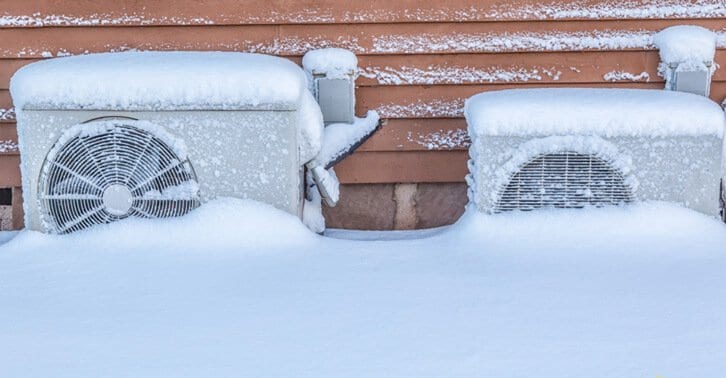Ways to Defrost the Frozen AC Pipe: Professional Guidance
Ways to Defrost the Frozen AC Pipe: Professional Guidance
Blog Article
Have you been in search of additional info on Why Is Ice On My Outside Air Conditione?

Introduction
Discovering that your air conditioner pipeline is iced up can be concerning, specifically during warm summer months when you count on your a/c unit the most. Understanding what to do in such a scenario is vital to stop more damage to your cooling system and guarantee your comfort inside your home.
Comprehending the Causes
Numerous elements can contribute to the freezing of an a/c pipe. Understanding these reasons can assist you address the concern efficiently.
Lack of Airflow
One usual cause of a frozen AC pipe is inadequate air flow. When the air movement over the evaporator coil is restricted, it can cause the coil to go down below freezing temperature level, leading to ice development on the pipeline.
Reduced Refrigerant Levels
Insufficient refrigerant degrees in your AC system can likewise result in an icy pipeline. Low cooling agent levels can trigger the pressure in the system to go down, causing the cold of dampness on the evaporator coil.
Winter Conditions
In cooler climates, freezing temperatures outside can add to the freezing of a/c pipelines. If your air conditioning unit is not correctly shielded or if there are leakages in the ductwork, cool air can infiltrate the system, creating the pipe to freeze.
Dirty Air Filters
Dirty or blocked air filters can limit air movement in your air conditioner system, resulting in numerous issues, consisting of a frozen pipeline. It's important to replace or clean your air filters regularly to make sure correct air flow and prevent ice buildup.
Indicators of a Frozen A/c Pipe
Identifying the signs of a frozen air conditioner pipe is crucial for timely action.
Lowered Airflow
If you notice a considerable decline in air movement from your vents, it could indicate an icy pipe.
Ice Buildup on the Pipe
Noticeable ice accumulation on the cooling agent line or the evaporator coil is a clear indicator of a frozen air conditioner pipe.
Unusual Sounds from the Unit
Unusual noises, such as hissing or gurgling, coming from your air conditioning device can signal that there's ice present on the pipe.
Immediate Actions to Take
When confronted with an icy air conditioning pipeline, it's necessary to act rapidly to stop further damages to your air conditioning system.
Turning off the air conditioning
The first step is to turn off your air conditioning system to avoid the system from running and intensifying the concern.
Checking for Blockages
Inspect the area around the interior device for any obstructions that may be obstructing air movement, such as furnishings or drapes.
Thawing the Pipe
You can make use of mild methods like putting towels soaked in warm water around the icy pipeline to assist thaw it gradually.
Preventive Measures
Taking safety nets can aid avoid future events of an icy air conditioner pipe.
Routine Maintenance Checks
Schedule regular upkeep talk to a professional HVAC specialist to ensure that your air conditioner system is running effectively.
Changing Air Filters
Routinely replace or cleanse your air filters to avoid air movement limitations and keep optimal efficiency.
Insulating Exposed Pipes
If your air conditioning pipelines are exposed to chilly temperature levels, consider protecting them to stop cold during winter season.
Looking For Professional Help
If DIY approaches fall short to deal with the problem or if you're not sure concerning just how to continue, it's ideal to look for assistance from a qualified HVAC technician.
When DIY Methods Fail
If your attempts to thaw the pipe or address various other issues are unsuccessful, it's time to call a professional.
Value of Hiring a Professional HVAC Technician
A qualified HVAC technician has the know-how and tools required to identify and repair problems with your air conditioning system safely and efficiently.
Conclusion
Dealing with an icy air conditioner pipeline can be a frustrating experience, however recognizing just how to respond can help reduce damages and bring back convenience to your home. By comprehending the reasons, recognizing the signs, and taking timely activity, you can effectively attend to the problem and prevent future occurrences.
What to Do If Your AC Line Is Frozen
Make Sure All Supply and Return Air Vents Are Open
If you notice problems with airflow, the first thing you should do is check your supply and return vents. Supply vents distribute clean, conditioned air throughout your home. As this air becomes stale, it’s pulled into the return vent, where it’s reconditioned before being sent back out through the supply vent.
When these vents are closed, air won’t flow in the home. Before examining your AC, check the vents in every room and ensure they’re all open.
Check for a Dirty Air Filter
Another possible cause of limited airflow is a dirty air filter. Your air conditioner’s filters catch elements you don’t want to breathe in, such as dirt and dust. Over time, filters can become clogged, ultimately blocking air from flowing in and out. The lack of airflow can then cause the entire coil to freeze and will completely restrict any air from moving through it. The AC may need to be powered off for one to two days to allow the coil to thaw after replacing the filter to allow proper functioning of the unit. This debris can also accumulate on your AC’s evaporator coil, requiring a more serious repair. In general, air filters should be cleaned regularly (about every two weeks).
Assess Your Outdoor Unit
In addition to checking your AC, assessing the outdoor unit is a good idea. Also known as the condensing unit, it works with your interior unit to release heat outside. An issue with the outdoor unit can result in rising internal temperatures.
Overgrown Shrubs or Clogged Leaves
From leaves and twigs to shrubs and debris, there’s no shortage of outdoor elements that can accumulate around your condensing unit. When these elements get lodged inside the unit, they can block airflow. Fortunately, removing the blockage can solve the problem.
Sounds of a Broken Fan
Shrubs and leaves aren’t the only things that can impede your outdoor unit’s airflow. If the fan is broken, the unit won’t be able to properly get rid of heat — which means the internal temperature won’t go down. First, make sure the fan is spinning. If it is, check for the following sounds of a broken fan:
Buzzing Rattling Screeching Hissing Clicking Preventative Measures
Nobody wants to deal with a frozen AC line. In addition to causing problems with your air conditioner, they require professional repairs. On the bright side, there are preventative measures you can take to help ensure this issue doesn’t arise in the first place.
https://www.coopergreenteam.com/blog/what-to-do-if-ac-line-frozen

Do you really like reading about How can I fix an air conditioner’s frozen pipe?? Post a comment down the page. We would be glad to listen to your insights about this page. We are looking forward to see you back again in the future. Enjoyed our posting? Please share it. Let other people discover it. Thank-you for your time spent reading it.
Call Today Report this page